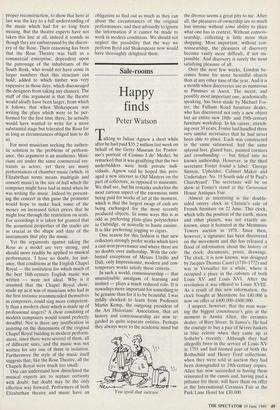Sale-rooms
Happy finds
Peter Watson
Talking to Julian Agnew a short while T after he had paid $35.2 million last week on behalf of the Getty Museum for Pontor- mo's portrait of Cosimo I de' Medici, he remarked that it was gratifying that the two underbidders were both private indi- viduals. Agnew said he hoped this pres- aged a new interest in Old Masters on the part of collectors, as opposed to museums. We shall see, but his remarks underline the most curious aspect of the enormous sums being paid for works of art at the moment, which is that the largest swags of cash are being exchanged for the most recently produced objects. In some ways this is as odd as preferring plate-glass polytechnics to Oxbridge, or nouvelle to haute cuisine. It is like preferring jogging to cigars. One reason for this fashion is that new collectors strongly prefer works which have a cast-iron provenance and where there are no doubts over authorship. With the cele- brated exceptions of Messrs Utrillo and Dali, only Impressionist, modern and con- temporary works satisfy these criteria.
In such a world, connoisseurship — that unanalysable amalgam of learning and instinct — plays a much reduced role. It is nowadays more important for something to be genuine than for it to be beautiful. I was mildly shocked to learn from Professor Martin Kemp, the outgoing president of the Art Historians' Association, that art history and connoisseurship are now re- garded as quite separate entities. Perhaps they always were to the academic mind but 'You spoil that suitcase.' the divorce seems a great pity to me. After all, the pleasures of ownership are so much less intense without some ability to place what one has in context. Without connois- seurship, collecting is little more than shopping. Most important, without con- noisseurship, the pleasures of discovery become vastly more difficult, if not im- possible. And discovery is surely the most satisfying pleasure of all.
Over the next few weeks, London be- comes home for more beautiful objects than at any other time of the year. And it is a month when discoveries are as numerous as Pimmses at Ascot. The nicest, and possibly most important one, academically speaking, has been made by Michael Fos- ter, the Fulham Road furniture dealer, who has discovered not only a new object but an entire new 18th- and 19th-century furniture workshop. In his career, stretch- ing over 30 years, Foster had handled three very similar secretaires that he had never been able to place. Each was constructed in the same satinwood, had the same splayed feet, glazed bars, painted cornices and crossbanding — but fitted into no known authorship. However, in the third secretaire Foster found a label: 'George Simson, Upholder, Cabinet Maker and Undertaker. No. 19 South side of St Paul's Churchyard'. The secretaire will be on show at Foster's stand at the Grosvenor House Antiques Fair.
Almost as interesting is the double- sided orrery clock in Christie's sale of French furniture on 22 June. This clock, which tells the position of the earth, moon and other planets, was not exactly un- known, since it featured in the Mentmore Towers auction in 1978. Since then, however, a signature has been discovered on the movement and this has released a flood of information about the history of the clock: documents, prints, drawings. The clock, it is now known, was designed by Jacques Thomas Castel (1710-1772) and was in Versailles for a while, where it occupied a place in the cabinets of both Louis XV and Louis XVI. After the revolution it was offered to Louis XVIII. As a result of this new information, the clock bought at Mentmore for £40,000 is now on offer at £400,000–£600,000.
I suspect, however, that the man wear- ing the biggest connoisseur's grin at the moment is Armin Allen, the ceramics dealer, of Bury Street, St James's. He had the courage to buy a pair of Sevres baskets in blue celeste when they came up at Sotheby's recently. Although they had allegedly been in the service of Louis XV in 1755 and had formed part of both the Rothschild and Henry Ford collections, when they were sold at auction they had been downgraded to 19th-century copies. Allen has now succeeded in having them reinstated in the canon and, having paid a pittance for them, will have them on offer at the International Ceramics Fair at the Park Lane Hotel for £30,000. As with people, objects with a myste- rious or chequered history are often far better company than their safer, but duller, rivals.



























































 Previous page
Previous page